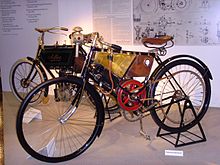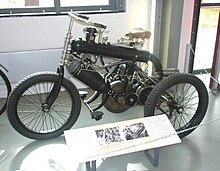Rüb (motorcycle)

The Rüb (also Rüb & Haab) from 1895 was a motorcycle of the German inventor and later aircraft designer Ludwig Rüb (* 1863 in Ulm ; † 1930).
Rüb, who previously worked in production at Wolfmüller , began building his own motorcycle in October 1894 together with the lathe operator Christian Haab; however, the first driving attempts are said not to have been made until September 1895. The Rüb consisted of a reinforced bicycle frame in which the lower frame train was replaced by the load-bearing motor and the upper frame tube carried a fuel tank. When two-cylinder tandem engine, the cylinder behind the other layers (the piston rod of the upper cylinder was connected through the sealed cylinder head with the piston crown of the lower cylinder), was the first time a Bosch - high voltage magneto ignition used in a motorcycle. The third innovation is the drive by means of a cardan shaft to the rear wheel.
Got into financial difficulties (the engine suffered from "teething problems") two donors stepped in; Since October 1, 1895 the company has been called Rüb and Wegelin . Rüb applied for patents for his bicycle with gasoline engine abroad on March 25, 1896 , but he was interested in aviation. In 1896 he left the company to work for Graf Zeppelin in Friedrichshafen . The new company was now called Motorfahrzeug-Werke Heinle & Wegelin (both former financiers of Rübs) and, following the trend, produced motor tricycles based on the De Dion-Bouton model in Augsburg until 1899, in addition to the "motorcycle (Rüb system)" . A motor tandem for sporting events was also part of the range.
Web links
Individual evidence
- ^ A b Karl Reese: Motorcycles from Munich . Johann Kleine Vennekate, Lemgo, 1st edition 2005, ISBN 3-935517-17-3 , p. 127
- ↑ a b c Max JB Rauck: The production motorcycle was 90 years old. In: deutsches-museum.de (PDF; 12.2 MB) Kultur & Technik, issue 1986, p. 92 ff (accessed on January 1, 2012)
- ↑ a b c Innovations in bicycles. In: Polytechnisches Journal . 311, 1899, pp. 154-158.

